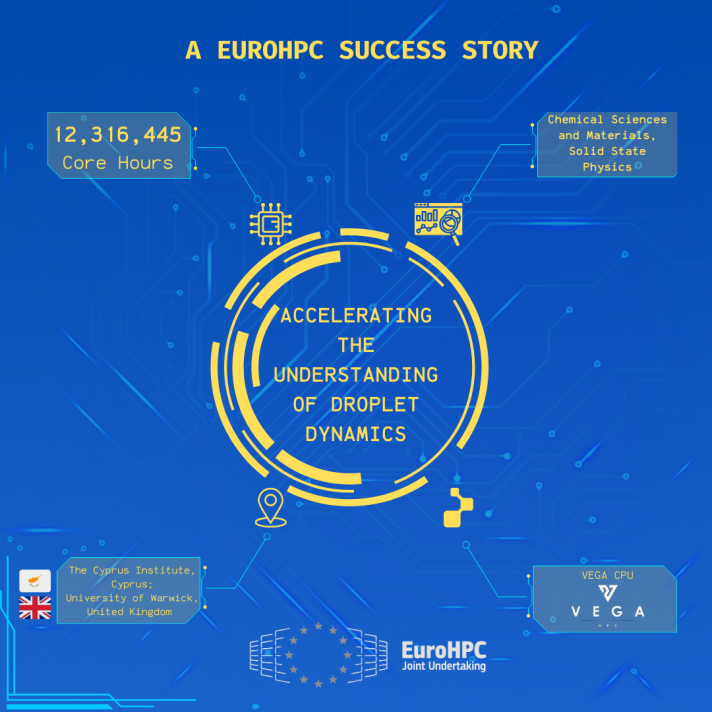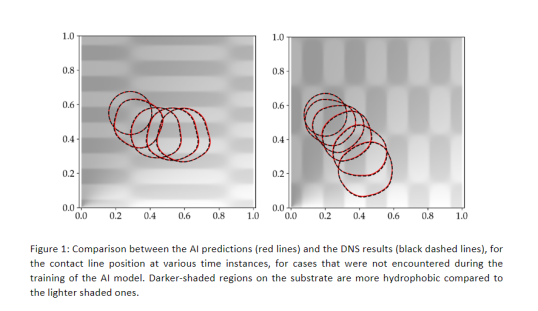Context and project goals
The intricate interplay of droplets on diverse surfaces is important for industry to understand this natural occurring phenomenon, in order to design materials that allow us to control the transport of droplets. The nature of this complex multi scale phenomenon poses considerable computational challenges. Within this context, EuroHPC JU has provided access to the EuroHPC Vega supercomputer to a research team from the Cyprus Institute, which seeks to perform numerical simulations in order to provide datasets in an attempt to harness the power of data-driven surrogate models. These models could replace conventional computational fluid dynamics methods, and considerably accelerate droplet dynamics simulations.
By leveraging the EuroHPC resources, the project generated datasets for the motion of droplets on surfaces with varied hydrophobic and hydrophilic regions. To achieve this, the team employed the code Basilisk - a powerful, open-source platform for solving partial differential equations on Cartesian grids - to perform direct numerical simulations (DNS). These datasets fuelled the development of data-driven models to predict droplet trajectories while incorporating insights from reduced-order analytical models.
The research team from the Cyprus Institute is working within the European Center of Excellence in exascale computing "Research on AI- and Simulation-Based Engineering at Exascale" (CoE RAISE), which has received funding from the European Union’s Horizon 2020 – Research and Innovation Framework Programme H2020-INFRAEDI-2019-1 under grant agreement no. 951733 (the financial support from the European Union’s Horizon 2020 research and innovation programme under grant agreement No 810660 (SimEA), and from the Cyprus Research and Innovation Foundation under contract No. EXCELLENCE/0421/0504 is also acknowledged).
Computational Methods
To tackle the multifaceted challenge of droplet dynamics, the project capitalizes on the Basilisk code. This code is critical for simulating droplet transport across heterogeneous substrates. The adaptive mesh refinement capabilities, which ensure that the fluid interface is accurately captured, in conjunction with an efficient iterative multigrid solver, contributed to efficiently creating a substantial dataset, which is a prerequisite for training data-driven models.
Using an earlier EuroHPC preparatory access call, the team identified the optimum computational parameters for this study (resolution requirements, time step, number of CPUs per job, etc.). Then, when they received the next allocation of time on a EuroHPC system, the research team was ready to start simulating wetting hydrodynamics cases very quickly. The datasets were then postprocessed and used for preliminary training and testing of data-driven models at the end of the 3rd and 6th month following the start of the allocation. This provided the opportunity to explore different AI methods, perform hyperparameter tuning and, in general, experiment with the AI workflow.
Technical Challenges
Since Basilisk is an established code for droplet dynamics research, the technical challenges were relatively minor. In addition, thanks to a strict data management plan with frequent data postprocessing and data transfers, and the prompt response of technical staff of the Vega EuroHPC, bottlenecks in handling these big datasets were avoided.
Societal Impacts
Studying the dynamics of liquids in contact with surfaces entails multiphysics processes that operate at disparate scales and can often pose formidable large-scale computing challenges. These challenges are overcome by resorting to low-fidelity modelling, which typically relies on empirical approximations to capture unresolved physics. However, this limited predictive capability is not desirable in applications of practical importance, where the need to control precisely how a liquid behaves when deposited on a surface is key. Thus, this project seeks to address the need for accurate and efficient data generation by adopting deep learning approaches to get high-fidelity simulations. Such efficient data-driven models can be used to inform strategies to control droplet transport.
The developed workflow is expected to be highly relevant to a broad spectrum of scientific and technological areas:
- Pharma/biomedicine: droplet-based microfluidic devices and lab-on-a-chip devices can batch-process very small volumes of chemical/biological samples, without the need of large-scale laboratory equipment. These devices may also be used in high-throughput drug screening. Also, understanding the behavior of droplets in various pharmaceutical processes is critical for quality control and ensuring consistent product quality.
- Smart materials: self-cleaning surfaces, either with super-hydrophobic or super-hydrophilic coatings, have application on windows, pv panels, etc.
- Energy harvesting: triboelectric energy generators can convert the kinetic energy of rain droplets to electrical energy.
- Printing: droplet-based 3d printing techniques
Employment and future utilisation of EuroHPC resources
Generating large amounts of data in order to train AI models can be a very intensive process. For datasets of complex engineering cases, handling the increased computational cost due to the increased resolution requirements becomes even more challenging. To ensure the successful implementation of the project by improving accuracy (e.g., by using finer spatial resolution) and/or generating ever bigger datasets, obtaining access to EuroHPC supercomputers is of the outmost importance. In summary, executing the overall workflow in a reasonable time frame becomes possible only on large-scale computing infrastructures such as the ones provided through EuroHPC.

